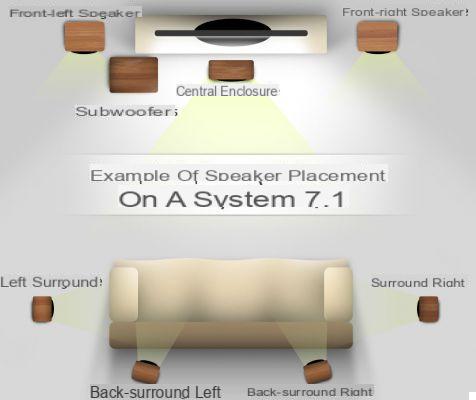
Whether you've just purchased a new home cinema kit or already own one, everyone wants the same thing: to make the most of the sound experience one could expect. However, the delicate and essential question of the location of the speakers arises, in particular in the case of a 5.1 multichannel system. In addition, there are architectural, decorative and surface constraints. We are therefore going to give you the tools to properly install such a set, with theoretical bases followed by practical examples.
The theoretical and technical approach
Before rolling up our sleeves and getting to the heart of the problem, it is advisable to take stock of the theory, which will allow you to better approach and understand certain sound concepts, in order to place your speakers effectively. We are therefore going to put on our most beautiful glasses and focus on the most essential recommendations, because there are so many of them: you will thus escape the 400 points of the THX standard, you can thank us.
Recommendations from international professional bodies (UER / EBU 3276, AES AESTD1001 and SMPTE RP200).
Nothing like a good diagram to avoid long speeches. You can already see some basic placement and orientation rules in an optimal room. As a reminder, we are talking about a 5.1 system made up at the front of the left (L), center (C) and right (R) speakers and, at the rear, of the rear-left (LS) and rear speakers. right (RS). The subwoofer, also called LFE (Low Frequency Effect) channel, is not shown in the diagram, because the speakers used are said to be full band, which means that they reproduce all the sounds audible by the human ear, from the lowest to the highest, so there is no need for a subwoofer in such a configuration.
In this environment the speakers should be placed at listening height at an angle of 0 °, directed towards the listening area and at the same distance from the listener. In the case of a video projector and a perforated screen, the central speaker can be placed behind the screen towards its lower half. If, however, the rear speakers cannot be at the right distance and especially closer to the listeners than the other speakers, it will be necessary to add a delay available in the amplifier settings. In addition, the speakers should not be placed in a niche or cavity to avoid the effects of resonances of certain frequencies. The reference listening level for a 5.1 listening system should be 85 dB (C).
In theory still, but more subtle this time: in a multichannel configuration, unlike a stereophonic configuration, it is necessary to favor a room with absorbent materials placed everywhere to obtain a very short reverberation time and therefore to avoid the effects. that we find, exaggeratingly, in large rooms or empty corridors. This reverberation time must be less than 0,3 seconds and the first reflections of the room, more roughly the first moments of reverberation, must have a level less than 10 dB in the direct field (the signal which comes directly to us from the speakers to our ears). For the more mathematical and advanced among you, you can find some small calculation tools in our box at the bottom of the page.
And now, practice!
Obviously, we are not in the enchanted world of Care Bears and all these recommendations are very complicated to apply at home, between tiled rooms, windows, different architectures and types of surfaces, decoration, everyone's layout preferences. … Just know that there is no miracle solution and that it is necessary above all to appeal to your common sense and your ears. Remember also that the acoustics of a room are a very important factor in the final rendering, so think of rugs, curtains, full bookcases ... to best absorb the sound in your room, failing to be able to devote an entire room to the home movie theater.
Compared to theory, the first changes are in the architecture and the surface of the room. Obviously, it is difficult to really act at this level, which is why we will rely on several examples. Another factor, the arrangement and the decoration of the room are elements to take into account and to which it will be necessary to adapt, but while trying to make some concessions. In addition, some amplifiers have a speaker calibration system using a dedicated protocol and a microphone supplied, more or less elaborate and precise depending on the model. These automatic systems are very practical for optimizing the sound reproduction when the placement is not perfect.
Let's take a closer look at this first example in a small room equipped with a home cinema composed only of speakers in satellite format and a small subwoofer. First of all, the front and center speakers are grouped together and confined to the TV cabinet, which greatly reduces the stereophonic width in relation to the listening place and leads to a great deal of imprecision in terms of spatialization and the feeling of envelopment. The second concerns the LS / RS speakers which are positioned very close to the listener, but above all directed towards the television: it is impossible to take advantage of the rear channels in this arrangement. The subwoofer is also placed below the TV cabinet; it is discreet, but it causes the furniture to vibrate and consequently disturbs the signal. Note, however, that the positioning of a subwoofer in a room is less critical, since the bass is not directive. We can thus indifferently put it to the right or to the left of the listening position.
The advantage of satellites is that they can be easily attached to walls - often a simple screw is sufficient. So we'll start by expanding the stereo broadcast by placing the L and R speakers on the walls on either side of the screen, leaving more space for the center channel to speak. You can also place them on stands if it is not possible to secure them, or if they are compact speakers for example. As for LS and RS, on the other hand, the wall mounting box is essential. Since the sofa is against the wall, a 90 ° placement can be tolerated as long as they target the listener's location and are positioned higher than the head. However, care must be taken to keep a balanced volume and therefore lower the volume of the rear channels, as they are closer to the listener than the front ones; it is also advisable to apply the famous delay if possible, to delay the sound of a few milliseconds at the back. As for the LFE, it can now find its place on the right side of the TV. A few small decorative elements can help with the acoustics of the room: a rug can be placed under the coffee table and curtains in front of the windows, for example.
If ever the layout of the living room were to change, this is what can be envisaged in terms of the placement of the kit. The satellites will also be placed on the wall with the same recommendations as before.
Another example in a different environment. For the moment, only a stereophonic configuration is in place and shows a big mistake in the placement of the L / R speakers, placed on the ground and much too tight. We are very far from having an equilateral triangle and therefore a beautiful stereophony.
First of all, let's make the most of the width of the wall by moving the L and R speakers away from the TV cabinet. It is then possible to position the LFE between the cabinet and the loudspeaker R. With regard to the LS and RS, two solutions are possible: the first, optimal, consists in fixing the loudspeakers to the wall, again at equidistant from the ideal listening position, while the second, less optimized, consists of placing the speakers on the two pieces of furniture that surround the sofa. These are at a sufficient height, but the placement and the distance are not optimal and it is necessary to decrease the volume of these channels, to apply a delay as well as to place absorbent materials underneath - hoping that the cabinet is filled enough and massive so as not to accentuate the vibrations too much. Here again, we recommend adding a carpet and curtains to better absorb and homogenize the sound diffusion in the room.
Third example in a larger room. Here again, only a front stereo setup is present, but the TV stand is in a corner while the sofa is not directly in front. The L / R tower speakers are very poorly directed here and do not target the listening point well, in addition to being confined near the cabinet.
Either way, the position of the speakers will not be optimal, especially for the person sitting in the chair, but let's try to work things out. There again, we separate the two column speakers and orient the speaker L. If by chance a subwoofer came to accompany the assembly, it could be placed to the right of the TV cabinet. More complicated on the other hand for the LS / RS loudspeakers which are this time compact loudspeakers. Luckily, the cabinet on the left is small enough to accommodate the speaker, in which case you would have had to move the cabinet and put the speaker on a stand. The RS loudspeaker, on the other hand, must be placed on a stand. Care should be taken to keep the same distance between the listening center and each of the rear speakers, to manage their volume and the delay. Obviously, repositioning the furniture can drastically simplify the configuration.
Finally, the last example with a more powerful 5.1 system, made up of front column speakers and compact surround speakers. The most problematic element here is the placement of the L / R speakers and the subwoofer.
It is true that placing the latter closer to a corner increases its performance, but this is not necessary for this type of installation and this type of sufficiently powerful box. Putting it to the left of the TV cabinet in this configuration will limit the transmission of vibrations with adjacent rooms. The LS / RS loudspeakers are already well positioned, but if ever they are satellites, it is possible to place them on the walls at 90 °. For better distribution and efficiency, it is possible to equip yourself with so-called bipolar or tripolar satellite speakers, which can broadcast the signal in two or three directions.


























